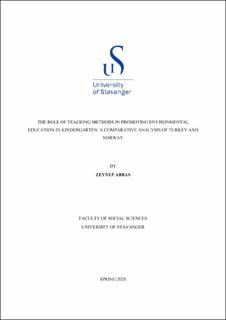| dc.contributor.advisor | Sageidet, Barbara Maria | |
| dc.contributor.author | Abbas, Zeynep | |
| dc.date.accessioned | 2020-12-11T10:32:59Z | |
| dc.date.available | 2020-12-11T10:32:59Z | |
| dc.date.issued | 2020-08 | |
| dc.identifier.uri | https://hdl.handle.net/11250/2717107 | |
| dc.description | Master's thesis in Energy, Environment and Society | en_US |
| dc.description.abstract | Environmental education (EE) has a pivotal role in promoting environmental protection and awareness in society. This paper claims that in order to achieve developments in EE, in kindergartens, teaching methods are the key. It also highlights the significant role of culture in promoting children’s positive attitudes towards the environment. Regarding the limited amount of literature and research on how teaching methods affect environmental education in kindergartens, this paper will contribute to the relevant research area by presenting what kinds of teaching methods seem to have positive effects on children’s understanding of the environment and their attitude towards it. Turkey and Norway have been chosen for the analysis in order to see what causes possible differences between these two in the implementation of EE in kindergartens. A Qualitative research strategy has been applied in this thesis. Along with the literature review, in-depth interviews with kindergarten teachers and educational administers from Turkey and Norway have been carried out. With this aim, a semi-structured interview guide has been prepared by the researcher. Findings of this study indicate that there is a close relationship between education and sustainable development (SD). It was also found that there seem to be four main teaching methods that have been used and/or recommended by kindergarten teachers from Norway and Turkey; (1) exposure to the natural environment (2) learning by experience (3) project method (4) visuals: images and videos. Based on this, it was revealed that the kindergarten teachers from Norway seem to focus more on “education in and for the environment” mostly by providing children regular exposure to the natural environment, while the kindergarten teachers from Turkey seem to focus more on “education about the environment” usually by promoting indoor environmental education with the use of visuals such as images and videos. The findings also seem to reveal that culture has a significant role in shaping children’s understanding of the environment and their attitude towards it. Lastly, the results of this study point out that teachers are role models for children in developing positive attitudes towards the environment and, there is a need for environmental education for teachers, as well. | en_US |
| dc.language.iso | eng | en_US |
| dc.publisher | University of Stavanger, Norway | en_US |
| dc.relation.ispartofseries | Masteroppgave/UIS-SV-IMS/2020; | |
| dc.subject | environmental education | en_US |
| dc.subject | sustainability | en_US |
| dc.subject | kindergarten | en_US |
| dc.subject | teaching methods | en_US |
| dc.subject | bærekraft | en_US |
| dc.subject | barnehage | en_US |
| dc.subject | miljø | en_US |
| dc.title | The role of teaching methods in promoting environmental education in kindergarten: A comparative analysis of Turkey and Norway | en_US |
| dc.type | Master thesis | en_US |
| dc.subject.nsi | VDP::Samfunnsvitenskap: 200 | en_US |
